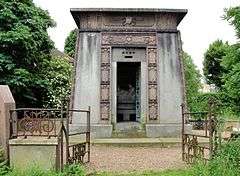Kilmorey Mausoleum
| Kilmorey Mausoleum | |
|---|---|
 Entrance to The Kilmorey Mausoleum | |
| General information | |
| Type | Mausoleum |
| Architectural style | Egyptian Revival |
| Address | St Margarets Road |
| Town or city | St Margarets, London Borough of Richmond upon Thames |
| Country | England |
| Coordinates | 51°27′40″N 0°19′22″W / 51.46112°N 0.32288°WCoordinates: 51°27′40″N 0°19′22″W / 51.46112°N 0.32288°W |
| Construction started | c. 1853 |
| Owner | Richmond upon Thames Borough Council |
| Designations | Grade II*[1] |
The Kilmorey Mausoleum, in St Margarets in the London Borough of Richmond upon Thames, is a Grade II* listed[1] mausoleum in the style of an ancient Egyptian monument and has been described as a "fine example of an Egyptian-style mausoleum, with an unusually good interior".[1] Designed by Henry Edward Kendall Jr. (1805–85)[1][2] and built, at a cost of £30,000,[3][4]in pink and grey granite with a bronze door,[1] it was commissioned in the 1850s by the 2nd Earl of Kilmorey (1787–1880) and contains the bodies of the Earl and his mistress, Priscilla Anne Hoste (1823–1854).
Priscilla died of heart disease on 21 October 1854, and she was buried in the mausoleum, with the inscription "Priscilla, the beloved of Francis Jack, Earl of Kilmorey".
When Kilmorey himself died in June 1880, aged 92, he was buried beside her in the mausoleum underneath a bas-relief in white marble showing the dying Priscilla on a couch surrounded by her lover and ten-year-old son Charles (b.1844). The bas-relief was carved in Rome by portrait sculptor Lawrence Macdonald (1799–1878).[3]
Location and ownership
Originally erected in Brompton Cemetery, the mausoleum was moved first to Woburn Park near Weybridge in about 1862, and from there to its present location in about 1868.[1]
In 1936 the grounds of the mausoleum were passed on in perpetuity to Hounslow Borough Council on condition that access would be maintained. Following changes to the Hounslow/ Richmond local borough boundaries in 1994, the mausoleum became the responsibility of Richmond upon Thames London Borough Council.[5]
The mausoleum today
The mausoleum, including the enclosure wall, railings and gate, are Grade II* listed[1] and are on Historic England's At Risk Register.[6] The surrounding cast iron railings, which in contrast to the building's Egyptian revival theme, are in a Gothic revival style,[7] are in a poor condition and discussions on sources of grant funding are underway.[6]
Situated in a wildlife site of about a third of an acre, the mausoleum is run and maintained entirely by volunteers, with assistance from the Environment Trust for Richmond upon Thames, and a contribution from Richmond upon Thames Council and English Heritage. It is occasionally opened to the public.[3]
Further reading
- A C B Urwin, The Second Earl of Kilmorey and his Mausoleum in St Margarets (Borough of Twickenham Local History Society, paper no. 75, 1997)[1]
- A C B Urwin, The Story of Gordon, Lacey and St Margarets Houses (The Hounslow and District Society, 1974)[1]
- Original drawings of the mausoleum, signed by Kendall and Pope, architects, of 33 Brunswick Square, are at The National Archives, ref. WORK 38/46.[1]
References
- 1 2 3 4 5 6 7 8 9 10 Historic England. "The Kilmorey Mausoleum, including enclosure wall, railings and gate (1240128)". National Heritage List for England.
- ↑ with an unidentified "Pope": Curl, James Stevens (2005). The Egyptian Revival: Ancient Egypt as the Inspiration for Design Motifs in the West. Abingdon / New York: Routledge. ISBN 9780415361194.
- 1 2 3 "Home page". Kilmorey Mausoleum. Retrieved 2 December 2013.
- ↑ Rachel Bishop (14 June 2013). "Egyptian tomb was damaged by repairs". Richmond and Twickenham Times (London). p. 4.
- ↑ "Factsheet on Kilmorey Mausoleum". London Open House. Retrieved 2 December 2013.
- 1 2 "The Kilmorey Mausoleum, including enclosure wall, railings and gate". Heritage at Risk. Historic England. Retrieved 11 June 2015.
- ↑ "Architectural Features of the Mausoleum". Kilmorey Mausoleum. Retrieved 2 December 2013.
External links
| ||||||||
